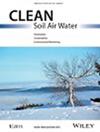Machine learning‐based regional flood frequency analysis of Indian watersheds
IF 1.5
4区 环境科学与生态学
Q4 ENVIRONMENTAL SCIENCES
引用次数: 0
Abstract
Abstract Estimates of the flood quantile for ungauged watersheds are crucial for water resources management but challenging due to the nonlinear complex hydrological system. For ungauged watersheds, estimating flood quantiles relies on various interdependent physiometeorological variables, many of which are not adequately considered in regional flood frequency analysis (RFFA). In this study, we utilized the random forest (RF) and support vector regression (SVR) algorithms, which can learn the nonlinear relationship between the physiometeorological variables and flood quantiles for RFFA. Thirteen physiometeorological variables that were not collectively employed before were used to estimate the 10‐year, 50‐year, and 100‐year return period flood quantiles (Q10, Q50, and Q100), respectively, for 39 watersheds spread across India. The RF and SVR models were trained on 29 (75%) watersheds to estimate individual flood quantiles and were subsequently tested on the remaining ten (25%) ungauged watersheds. The R 2 achieved by RF is 0.862, 0.813, and 0.845, and SVR is 0.807, 0.793, and 0.789 for Q10, Q50, and Q100, respectively. Overall, the results indicate that RF can effectively learn the nonlinear relationships, while SVR with a linear kernel requires further improvement to estimate reliable flood quantiles. The study demonstrates that machine learning algorithms, with appropriate physiometeorological input datasets, can be used to estimate flood quantiles even in the sparse data region.基于机器学习的印度流域区域洪水频率分析
未计量流域洪水分位数的估算对于水资源管理至关重要,但由于水文系统的非线性复杂性,这一估算具有挑战性。对于未测量的流域,估计洪水分位数依赖于各种相互依存的生理气象变量,其中许多变量在区域洪水频率分析(RFFA)中没有得到充分考虑。在本研究中,我们利用随机森林(RF)和支持向量回归(SVR)算法来学习自然气象变量与洪水分位数之间的非线性关系。13个以前未被集体使用的生理气象变量分别用于估计印度39个流域的10年、50年和100年汛期洪水分位数(Q10、Q50和Q100)。RF和SVR模型在29个(75%)流域进行了训练,以估计单个洪水分位数,随后在剩余的10个(25%)未测量的流域进行了测试。Q10、Q50和Q100的RF获得的r2分别为0.862、0.813和0.845,SVR分别为0.807、0.793和0.789。总体而言,研究结果表明,RF可以有效地学习非线性关系,而具有线性核的SVR需要进一步改进以估计可靠的洪水分位数。该研究表明,机器学习算法在适当的自然气象输入数据集下,即使在稀疏数据区域也可以用于估计洪水分位数。
本文章由计算机程序翻译,如有差异,请以英文原文为准。
求助全文
约1分钟内获得全文
求助全文
来源期刊

Clean-soil Air Water
环境科学-海洋与淡水生物学
CiteScore
2.80
自引率
5.90%
发文量
88
审稿时长
3.6 months
期刊介绍:
CLEAN covers all aspects of Sustainability and Environmental Safety. The journal focuses on organ/human--environment interactions giving interdisciplinary insights on a broad range of topics including air pollution, waste management, the water cycle, and environmental conservation. With a 2019 Journal Impact Factor of 1.603 (Journal Citation Reports (Clarivate Analytics, 2020), the journal publishes an attractive mixture of peer-reviewed scientific reviews, research papers, and short communications.
Papers dealing with environmental sustainability issues from such fields as agriculture, biological sciences, energy, food sciences, geography, geology, meteorology, nutrition, soil and water sciences, etc., are welcome.
 求助内容:
求助内容: 应助结果提醒方式:
应助结果提醒方式:


